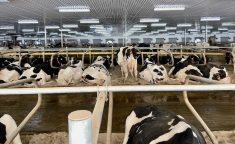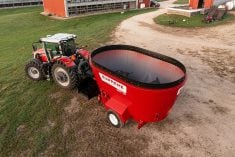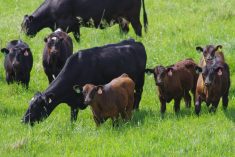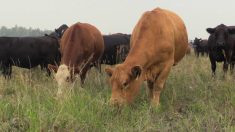Manitobans watched with horror in the third week of May as raging northern fires were joined by blazes in eastern Manitoba that led to a string of communities being evacuated and claimed the lives of two people.
Several wildfires crept into farm areas. Fires at Lac du Bonnet, edging close to fields at the Pas, in the RM of Piney and the RM of St. Clements were all still classified as out of control by the province’s wildfire service May 14. The fire in the RM of Piney sat at 7,886 hectares five days after sparking. The fast-moving fire that killed a man and woman near Lac du Bonnet had retreated to 4,008 hectares. In the RM of St. Clements, 5,000 hectares was in the fire zone, while fire near the Pas still covered a whopping 42,651 hectares.
WHY IT MATTERS: Manitoba’s dry spring left conditions tinder dry and ripe for fires to start.
Read Also

Lactanet moves to monthly on dairy genetic reports
Lactanet is now publishing monthly dairy genetic evaluations, giving dairy farmers more up-to-date data to make breeding decisions.
Auction marts opened their doors as community evacuation notices rolled in. Heartland Livestock Services in Virden and Grunthal Auction Mart both posted to social media, offering to house livestock displaced by the fires.
“(The) biggest thing is if somebody’s got threats or their cattle could be in danger, we just want to offer them a safe space, safe spot to go for a couple (or) three days until that that risk has passed,” said Brennin Jack, Heartland Livestock Services general manager. “And doesn’t matter if it’s a customer of ours or somebody that’s never dealt with us before; our doors are open to anybody in Manitoba or Saskatchewan.”
Heartland’s Virden location is one of the biggest in Manitoba, with capacity for 6,000 head. Grunthal is a bit smaller, with capacity for around 2,000. Both will be fielding housing requests for cows, horses, goats, sheep and any other livestock that needs to be removed from fire threat. Both have said they will provide feed and water for the animals while at their facility.
Brad Kehler, manager and auctioneer at Grunthal Auction Mart, said he’s taking steps to get extra feed should they need it.
Both auction marts said their move came out of a desire to serve the community.
“You look around and hear these stories of people in kind of threatened situations,” said Kehler. “And I just thought, you know, my goodness, we’re in the southeast corner here, and if there’s any way we can help our friends and neighbours out, we’d be happy to do it.”
For Heartland, the idea came after an employee’s pasture, home and cattle were threatened earlier this spring by a grass fire between Virden and Brandon.
It was one of several grass fires that local fire departments have turned out to fight this year, some of which have resulted in property damage.
Still taking stock of damage
Cindy Kellendonk, a councillor for the RM of Lac du Bonnet and a local farmer, said the fire is a crisis unlike anything the community has seen in nearly 40 years.
Kellendonk doesn’t have any livestock, but knows of neighbours and other producers in the area with horses, cattle and chickens who were working on evacuating. While she wasn’t sure where these producers stand in the situation, she believes many got all animals out, but there is a likelihood of some being left behind due to how fast the fire encroached and the area of highest intensity.
“In the worst of it, there are livestock producers, and we’re still waiting for an assessment update to find out exactly what the level of damage was,” she said. “So they are all out there working on this … and also (to) check to see if anybody else was left behind, if everybody got out that sort of thing.”
Throughout the crisis people have been connecting through the “Lac du Bonnet and Lovin’ It” Facebook page to offer help.
“The people community has been absolutely amazing. I cannot believe how quickly everybody came together,” Kellendonk said. “The volunteers, people opening up their homes, their properties, taking in livestock, putting people up in trailers, whatever they can do to help people through this.
The Manitoba Beef Producers said it is “actively monitoring the wildfire situation as it develops and is in touch with provincial officials on any response strategies that might be required to assist cattle producers.
The producer group has published resources on its website and social media that might be helpful to fire-impacted producers.
Throwing a line to fire-impacted farmers
As of May 15, the Grunthal auction hadn’t received any calls asking to house livestock. They’re viewing that as a good thing, since they’re only a few hours from both blazes in the RM of Piney and Lac du Bonnet.
Heartland, meanwhile, has had 10 people call about the initiative. Most come from Manitoba’s north and northeast. A few came from the Brandon area.
“They don’t have to quite pull them out yet, but definitely they’re willing to evacuate at an almost (moment’s) notice,” Jack said. “You know, there’s so much value in these livestock, whether it be horses, cattle, sheep, you know, dogs, cats, whatever that people need to have an evacuation plan.”
If producers can’t move all their livestock in a timely manner, Jack said help can be found.
“We have such a good network of trucks that work with us day in and day out,” he said, adding that “If you called me tomorrow and said, ‘You know what? The fires are getting too close for comfort, I’d just like to move these cattle out for two, three days.’ I’m almost certain that we could find out some sort of very economical price, or share that risk with some of those customers.”
Kehler agreed, saying that, should the situation become more serious, transport drivers will likely step up to help.
Livestock fire evacuation
Farm safety and fire experts list livestock evacuation plans on their fire check lists, which count down actions producers should take to minimize the chance of a spring farm fire.
David LeBlanc, a fire chief and director of protective services with Northern Sunrise County in Alberta, urged farmers to have an identification list handy of all their animals, including defining traits and health notes, during an interview with the Co-operator earlier this year.
Another Alberta expert said that, if animals can’t be evacuated, producers should cut their fences so that livestock are not trapped.
If possible, however, having a pre-set plan ready to go is an asset.
“We hope that we never have to see any (animals) … but the unfortunate reality is that if somebody needs to pull the pin and get them out of there, that they do it before the fires burning on their home quarter and that we can get them out of there in a timely fashion and not have any loss of life for their livestock or of humankind,” Jack said. “People do tend to put their livestock ahead of their own (lives), so we’re trying to avoid any anything scary like that happening.”
Widespread fires in Manitoba
As of May 15, there were 21 active fires in Manitoba, making it one of the most active wildfire areas in the country, due to fire complexity, journalists heard during a fire update. The blaze in Nopiming Provincial Park is the largest, covering nearly 100,000 hectares. The Lac du Bonnet fire was called a predominant concern for the Manitoba Government.
Forty firefighters from British Columbia have joined crews in the province, and a request was made through Canada Interagency Forest Fire Centre for an additional 80 firefighters.
“Typically, we wouldn’t be seeing a lot of, you know, this level of activity happening until later on in the summer,” said Kristin Hayward, Manitoba assistant deputy minister of the Conservation Officer Service and Manitoba Wildfire Service, during a May 14 press conference.
“We (normally) deal with the short kind of grass fire season before things greened up, and then have a little bit of a break before the forest fire started. But we are seeing that our seasons are starting a lot earlier. We’re out on the landscape, fighting forest fires probably a month earlier than historically we would be used to.”
Jack further urged people to be fire safe and follow fire bans, given the number of current fires that are human caused. A fire “can spark and blow five miles away and start a grass fire that is can be devastating to someone else,” he said.
According to the Manitoba Wildfire Service, 79 of the 80 fires so far this year were human caused.
















